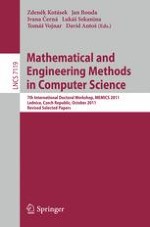This volume constitutes the thoroughly refereed post-conference proceedings of the 7th International Doctoral Workshop on Mathematical and Engineering Methods in Computer Science, MEMICS 2011, held in Lednice, Czech Republic, on October 14-16, 2011.
The 13 revised full papers presented together with 6 invited talks were carefully reviewed and selected from 38 submissions. The papers address all current issues of mathematical and engineering methods in computer science, especially: software and hardware dependability, computer security, computer-aided analysis and verification, testing and diagnostics, simulation, parallel and distributed computing, grid computing, computer networks, modern hardware and its design, non-traditional computing architectures, software engineering, computational intelligence, quantum information processing, computer graphics and multimedia, signal, text, speech, and image processing, and theoretical computer science.
